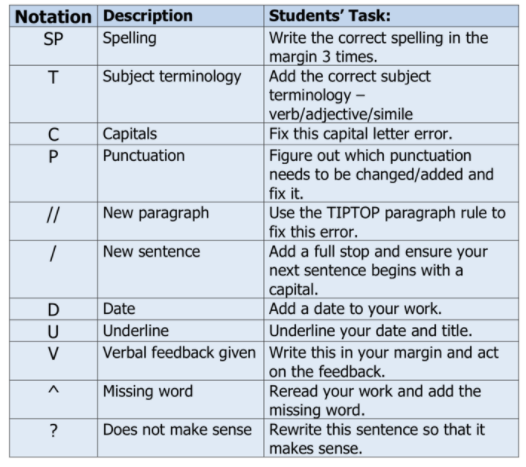Feedback
Feedback is regular and timely and occurs both during the lesson and through written feedback. Students are encouraged to engage with all feedback in Dedicated Improvement and Response Time (DIRT) activities. An ethic of excellence is promoted
Feedback not Marking
- Times have changed and a lot of meaningful research has been conducted, and there is now something of a consensus about the best way to approach the “marking” of student work.
- The word “Marking”, to most of us, means the teacher taking in work from students, reviewing it in great depth, adding ticks and crosses, comments, corrections, grades and so on, and returning it to the students, who then continue on with their work.
- Such an approach has now largely been debunked as being ineffective, and what is of much greater importance is that meaningful “Feedback” is given, that students can act upon. Moreover, this feedback should be as immediate as possible, and should be acted upon straight away.
Less Teacher-marking, more Teacher-led
- Students learn best when they have an element of autonomy over their work, when they have control and when they have the opportunity to think like the teacher or examiner.
- So we very much expect our teachers to “lead” students regularly in the marking and assessment of their own work, completing what is termed self-assessment and peer-assessment tasks, followed by immediate opportunities to improve, which we call “Personal Improvement Time” or PIT. Student feedback is given in green pen and should occur regularly.
- It is proven that students being supported in this manner to understand the strengths and areas for development of their own work, and that of their peers, is of prime importance in making exceptional progress.
Feedback approaches
- Feedback will regularly be given as a whole-class approach which is outlined in the ‘Marking and Feedback’ policy. Teachers will spend time reading students’ work in order to identify common misconceptions and common areas of strength. The teacher will spend time in subsequent lessons addressing these in a variety of ways in order to ensure that all students have a deep and clear understanding of the subject content.
- Regular Feedback has been shown to allow students to make greater and faster progress in their subjects as teachers become ever more responsive to the needs of the students in their classroom.
- Allowing teachers to spend less time writing comments in books provides them with greater opportunities to plan responsive lessons and time to re-teach areas which pupils may have found particularly challenging. Therefore, whilst purple ‘teacher pen’ will become less apparent in pupil books, the standard of work produced over time will become evidently improved due to the whole class feedback given.
- This process gives much greater weight to teacher-led self and peer-assessment techniques, with students using their green pen to make corrections, improvements and additions. There may be no ‘teacher pen’ in some books depending on the individual approach chosen within the department. These subject-specific approaches are published on the Subjects page.
Feedback Codes and What They Mean

Conclusion
- We believe we have adopted an approach to marking and feedback that is in line with some of the best educational thinking of the last few decades, which recognises that each individual child needs to be empowered to understand how they are progressing and to assess this, with expert input from teachers.
- Finally, it is worth noting that Subject Leaders make the overall decision as to the best feedback approaches to use in their subject areas, with insight and support from all classroom teachers.

 reception@ssscs.co.uk
reception@ssscs.co.uk 01622 754551
01622 754551








